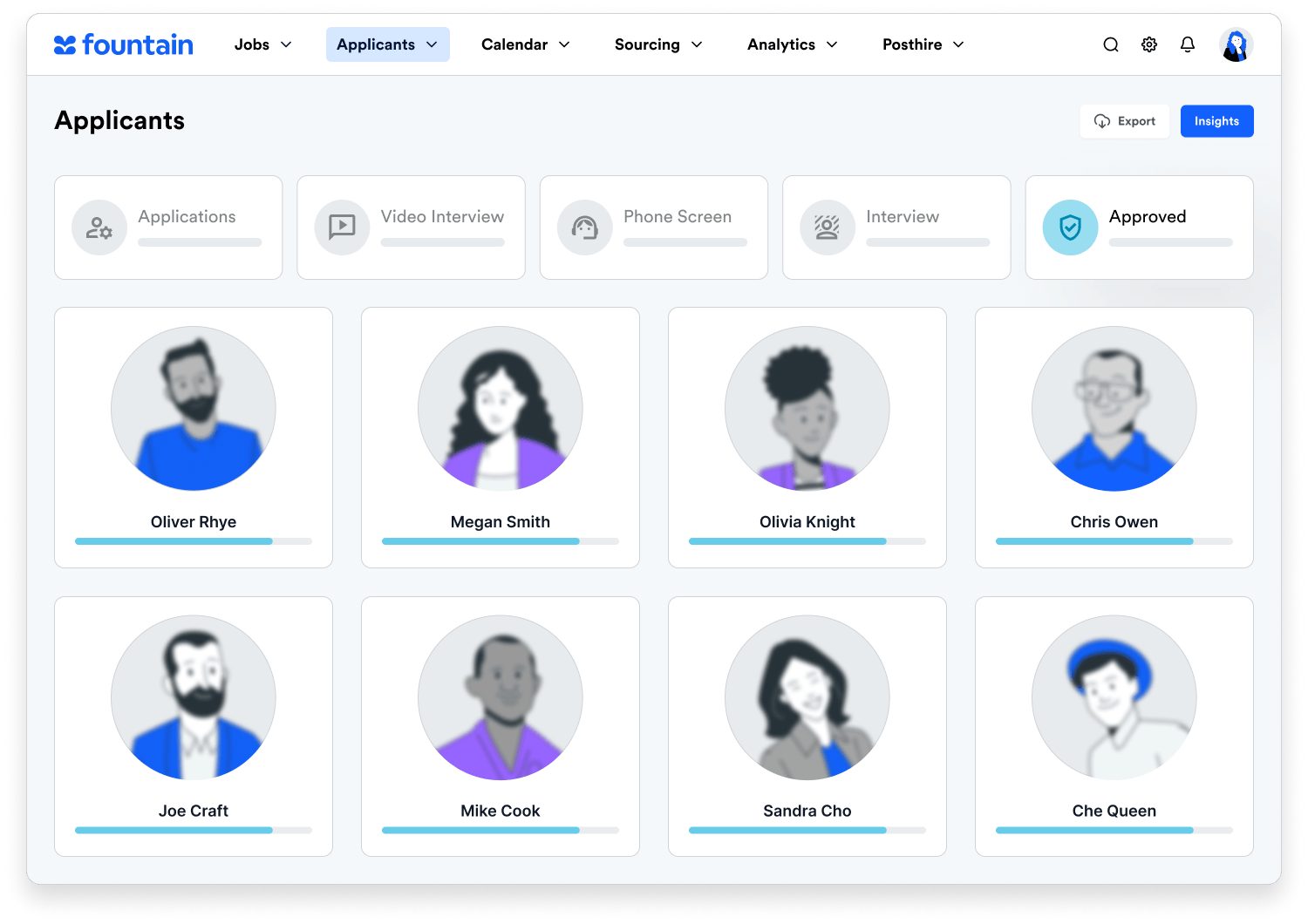How to effectively reduce time to hire: Strategies and solutions
The ability to hire fast is no longer just a bonus of select applicant tracking systems. In today’s fast-paced hiring game, it’s absolutely essential. But hiring teams still struggle to excel at this ever-important metric, with 38% of HR professionals reporting time to hire as their biggest pain point, according to a report from Morning Consult and Fountain.
But it’s simple math: A short time to hire increases the likelihood that your company will secure the most qualified candidates before they’re snatched up by the competition, and this metric is one of the best indicators of hiring success.
Importance of reducing time to hire
Reducing time to hire is not just about filling positions quickly but it’s also about improving the overall quality of hires and enhancing the candidate experience. A streamlined hiring process accomplishes the following”
- Enhances employer branding: A swift and efficient process improves the candidate experience, reflecting positively on your employer brand.
- Secures top talent: Top candidates are in high demand and usually have multiple offers; a reduced hiring time helps in securing such candidates before your competitors do.
- Boosts productivity: Filling positions promptly ensures that projects don’t lag and therefore maintains the momentum of your organizational productivity.
- Minimizes hiring costs: A protracted hiring process can inflate recruitment costs, affecting your overall budget adversely.
What is time to hire?
Average time to hire is the total amount of time that elapses from when a candidate starts a job application to when the candidate accepts a job offer.
According to LinkedIn’s Global Recruiting Trends, the average time to hire varies significantly for different industries and can last from a few days to up to four months.
Analyzing the time to hire KPI gives you insight into:
- How long it takes your company to recognize you have the most suitable candidate
- Any delays and bottlenecks in your hiring process
- The speed at which your company acts when the ideal candidate is identified
By optimizing this metric, you’ll make recruiting the right candidates easier and more efficient.
Differentiating between ‘time to hire’ and ‘time to fill’
Time to fill and time to hire are sometimes used interchangeably. However, there is a difference.
Time to fill is a separate hiring metric that’s also important for your company to track. Time to fill is the time between when your company posts a job vacancy and when the applicant starts the job.
In contrast, time to hire is concerned with when the offer is accepted, and not when the candidate starts the job.
Why track time-to-hire metrics?
Simple and smart hiring includes managing your talent pipeline to ensure that the available pool of candidates experiences a smooth and straightforward process, from application to job acceptance.

Average time to hire by industry
According to Lightcast.io, the average times to hire by industry are as follows:
- Food services: 27 days
- Hospitality and leisure: 21 to 25 days
- Healthcare: 24 to 49 days
- Manufacturing: 24 to 31 days
- Retail: 25 to 26 days
- Transportation: 25 to 26 days
By the time these industries extend offers, candidates are likely to have moved on to another employer who can hire them faster. Such an employer might use a frontline applicant tracking system (ATS) like Fountain, which has proven to help companies reduce time to hire to as little as two days.
But before we explore Fountain’s frontline hiring capabilities, let’s explore the effects of a slow time to hire.
How slow hiring affects your business
Being saddled with a slow hiring process affects all aspects of your business. Keep reading to learn how.
Losing quality candidates
Qualified candidates won’t wait around long for an employer to extend a job offer, and they’re likely applying for multiple jobs at the same time. If your average time to hire is slower than your competitors, candidates might move on before you can even review their application.
Productivity and revenue loss
A slow time to hire means that vacant positions are open for an extended amount of time. You might be saving on wages while the role is vacant, but your company will be missing out on the benefits of worker productivity. A delay in the time to hire may cost your company more money, especially if you have to hire an independent contractor to carry out critical tasks while you find a permanent replacement.
Risking damage to your company’s reputation
Your brand can suffer as a result of a slow time to hire. From the first interaction with potential candidates, they’re developing an opinion of your company. If their perception is negative, they might take this impression to social media or company review sites like Glassdoor. This could have a negative impact on the type of candidates you attract going forward.
To improve your time-to-hire KPI and avoid the negative consequences of delays in your hiring process, which can directly affect operating costs, you’ll need to identify the aspects of recruiting that cause delays and bottlenecks.
Top strategies to reduce time to hire
To learn how to reduce time to hire, we’ve offered a few tips to help you get started.
Train hiring managers
Hiring managers need to be supported in learning how to reduce time to hire, while also maintaining a high-quality stream of candidates. The first step is to ensure they’re equipped with the best high volume hiring platform and that they have adequate training with their system.
Streamline your requisition approval process
Traditionally, the formal process to fill an open position involved completing long forms and waiting for leadership to sign off on the request.
To reduce time to hire, you should consider improving the requisition process by:
- Getting rid of paper. Use electronic document collection and analysis to accelerate the requisition process. Electronic signature software like HelloSign can request signatures and send reminders to candidates until the requisition is signed.
- Automating the requisition process. Add the requisition to your hiring process workflow and set targets and reminders for managers to act.
Write better job descriptions
A job description should include the necessary details to provide the candidate with enough information to make a decision about whether to apply. However, including too much information in a job description not only wastes management’s time but also can deter applicants from pursuing the role.
Cut down on the time and unnecessary details in job descriptions by:
- Writing web-friendly descriptions. The job description should be written in clear, everyday language. If the candidate is reading your job description on a mobile device, they’ll likely skim it to find the most important points.
- Describing daily tasks. Provide details for what is expected of a candidate on a day-to-day basis.
- Emphasizing the benefits. Use the job description to convince the candidate that your company is the best place to work. Give them reasons to choose you over your competitors by providing details of perks and benefits.
Making small changes to how you post your jobs can greatly improve your application process as a whole.
Optimize job postings
Manually posting job openings to multiple job boards can delay the hiring process as each job board has its own requirements. Additionally, hiring teams have to spend extra time monitoring each job board, which hinders hiring efficiency.
Reduce time to hire when posting jobs by:
- Exploring different job sites. Think beyond the typical job sites like Indeed and consider sites that post jobs for specific industries or cover certain geographies.
- Automating posting to job boards. Reduce the delays associated with posting your vacancies on job boards by using a tech-enabled ATS like Fountain to post to multiple job boards at the same time.
Effectively communicate with candidates
If you want to hire fast, you need to be able to effectively communicate with candidates.
Follow these tips to ensure your communication methods help reduce time to hire, even if you have thousands of applicants at one time:
- Use email and SMS. As soon as candidates submit their applications, the communication stream between your company and your candidate should begin. Start with a friendly automated message acknowledging receipt of the application, followed by timely email and text messages to keep your candidate updated on the progress of their application.
- Make your hiring process mobile-first. It’s likely that candidates will use their mobile phones for every part of the application process, like to check the status of their application. To facilitate fast hiring, your candidate should be able to access and respond to communication as well as perform other application functions on their mobile phones.
Pre-assess candidates to determine hireability
There can be a disparity between what is written on the application form and what the candidate is actually able to do once hired.
Adding a pre-assessment step to your hiring process can help reduce time to hire because only qualified candidates will make it to the final stages of the funnel. Meanwhile, unqualified candidates will be eliminated before you have to spend time and resources on the manual steps of your process.
Hire faster with the following pre-assessment tips:
- Use “knockout” questions. If you need to hire a large number of candidates at once, consider using knockout questions to pre-qualify applicants before they arrive in your inbox. If a candidate provides a wrong answer to one of these qualifying questions, such as not having a driver’s license, they will be eliminated from the process.

- Use video interviews. Interpersonal skills are an essential requirement for any job. You can analyze a candidate’s interpersonal skills by using video as a pre-assessment tool. Ask candidates to record a short video of themselves talking about their work experience and explaining why they are a good fit for the role.
Streamline candidate interviews
Interviews can be dreadfully time-consuming, and scheduling can be a nightmare. Reduce the delays associated with the interview process by trying out the following suggestions:
- Reduce the number of interviews. Use the pre-assessment tips above to decrease the number of candidates who are even eligible for a face-to-face interview.
- Conduct phone or virtual video interviews. In a remote world, phone and video interviews are becoming the norm. Lean into this technology to reduce traveling time and make this crucial step more convenient.
Automate your hiring process
Last but not least, automating manual steps in your hiring process is one of the best ways to reduce time to hire. You can implement automation in the following ways:
- Audit manual processes. Take stock of your current hiring process to identify manual processes that could be automated for speed.
- Adopt a frontline ATS. A tech-savvy ATS includes features like automated workflows and document uploads. By relying on technology to perform these functions, you’ll carve out time in the hiring process and get candidates to the final stages faster.
- Lean into artificial intelligence. Ai is here to stay. It’s already helped companies hire faster and make their processes more efficient. Explore ways to implement conversational AI and automation into your process to streamline communication and keep applicants engaged.
How Fountain can help you reduce time to hire
We’ve presented a lot of information, and we understand it can be overwhelming. But with Fountain as your frontline hiring ally, we’ll guide you every step of the way to ensure we build a tailor-made high volume hiring solution that meets your specific recruitment needs. From automation to fast messaging and Candidate AI Agent, let’s explore how we can help you reduce time to hire and get results like these.


